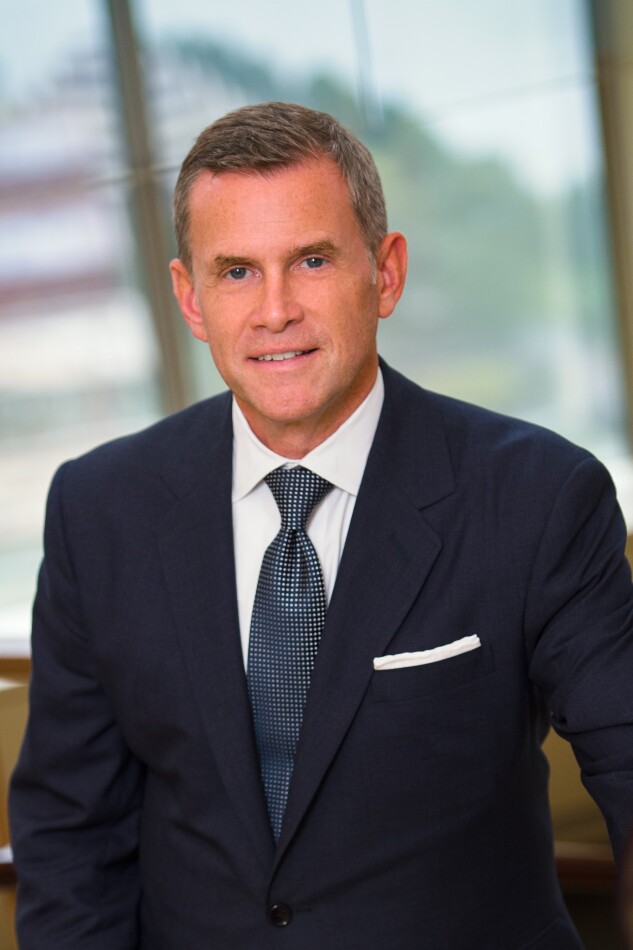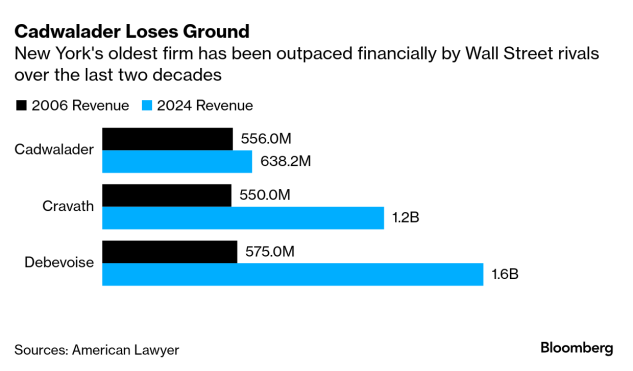Cadwalader Wickersham & Taft’s lawyer exodus forces a stark choice: stay the course and risk losing ground to competitors, or shake up the business model and possibly even consider a merger.
The Wall Street firm lost at least 33 partners since the start of the year, including some who bolted after Cadwalader struck an agreement in April with President Donald Trump for free legal services. The departures, tallied through hiring and retirement announcements and a person familiar with moves that haven’t been disclosed, total more than a fourth of the 125 partners the American Lawyer said the firm averaged last year. Cadwalader has also hired 10 partners this year, bringing net exits to less than a fifth of the partner class.
But it’s the nature of the exits—senior partners in core practice areas such as finance and capital markets—that is most damaging to the 233-year-old firm, New York’s oldest, because the business those lawyers brought in is difficult to replace, observers said. The departures follow the firm’s years-long slide down revenue rankings, even as partner profits stay high, and underscore a key maxim in the Big Law talent war: the quality of the exits trumps the number.
Cadwalader is showing signs it prefers the shake-up path. The firm is adding a second managing partner, Wesley Misson, to run Cadwalader alongside Patrick Quinn, according to a Friday internal memo obtained by Bloomberg Law that announced the change. Misson has served on the management committee, has “effectively” worked as co-managing partner for months, and has led “one of the most profitable practices” at the firm—finance, Quinn said the memo.
It’s “unsurprising” that competitors are poaching the firm’s partners, he said. “We have highly valuable assets that are appealing across the market,” Quinn told colleagues in the memo. The firm expects to gross more than $600 million in revenue this year, its second highest revenue performance on record, he said.
Quinn, a 37-year Cadwalader veteran of Cadwalader, is an accomplished corporate lawyer in the firm’s staple practice of asset securitization. He, Misson and Cadwalader’s representatives didn’t return requests for comment.
Business Generators
Cadwalader’s real estate finance co-head Bonnie Neuman left for Sidley Austin in April and brought three partners with her. Leveraged finance leader Ronald Lovelace jumped to Proskauer Rose in September and took three with him. And eight partners in Cadwalader’s capital markets practice left to join Orrick Herrington & Sutcliffe, including Washington, DC office managing partner Gregg Jubin, Bloomberg Law reported earlier this month, citing a person familiar with the move.
A key reason for some departures, besides chagrin over the Trump deal, is that partners see better opportunities at firms with a wider range of services than Cadwalader is known for, helping those lawyers more easily serve their clients, said Sabina Lippman, global managing partner at CenterPeak recruiting firm.
“When you see groups going to Orrick or Proskauer or Sidley, they’re going to firms that have a much more efficient cross selling platform,” she said.
While partners often part ways with their employers because management asked them to leave as underperformers, the quality of firms the Cadwalader defectors chose shows the attorneys were business generators, said Bruce Lubin, managing partner of legal recruiter BEL Partners. “People who are getting fired aren’t going to Sidley,” he said.
Lippman said the firm’s growth challenges in light of narrow brand recognition in a select few practices “suggests a Schulte-like dynamic.” Schulte Roth & Zabel, widely known for its expertise in investment management practices, tied up with the much larger McDermott Will & Emery this year to create McDermott Will & Schulte.
“If you look at what happened with Schulte, they were narrowly focused on areas they had strength in,” Lippman said. “They didn’t have diversity in practices.” More robust practices in litigation and restructuring would hedge against macroeconomic volatility, she said.
The firm would be an attractive candidate for a UK operator seeking New York credibility in corporate and finance, said New York based recruiter Alisa Levin. The firm is “going to have to make some dramatic changes,” she said.
Ranking Lag
Cadwalader for years has failed to keep up with the revenue growth of some key Wall Street rivals.
In 2007, just before the Great Recession rocked law firms’ financial practices, Cadwalader was the 39th biggest law firm in the US by revenue, according to American Lawyer rankings. The firm in its rank stood right between fellow New York white shoe firms Cravath Swaine & Moore and Debevoise & Plimpton. The following year, it let go of more than 100 lawyers, according to a 2008 Wall Street Journal article.
By the end of 2024, Cadwalader’s rank had fallen all the way to 85th. Debevoise rose to 33rd, and Cravath fell to 49th. The New York rivals more than doubled revenue over the past two decades to $1.6 billion and $1.2 billion, respectively, while Cadwalader grew just under 15% to $638 million.
Behind the numbers is the fact that Cadwalader’s revenue engines are practices highly sensitive to macroeconomic trends. The firm’s bread-and-butter capital markets and finance practices are highly reactive to interest rates. That means its revenue, profits, and ability to pay partners wax and wane with macro-economic markers.
Financial volatility poses a competitive threat in today’s legal industry, said John Morley, a Yale Law School professor who studies economic instability at law firms. A modest drop in profitability can cause a partner run for the door, taking colleagues and client relationships with them, he said.
“There’s an exit option and a stay option,” Morley said. “If the value of what Cadwalader is paying you declines to less than Paul Weiss, you move to Paul Weiss.”
Key Exits
Critical departures began this year with M&A partner Richard Brand’s move in February, along with three colleagues, to White & Case. Ryan McNaughton, a structured finance partner in New York, left for Davis Polk & Wardwell in March. McDermott, after its merger, recruited corporate co-chair Ira Schacter.
At least four partners who left were disappointed by the firm’s deal with the Trump administration, according to two people familiar with some of the moves. In April, Cadwalader said it would provide $100 million in free legal services to causes it agreed on with the administration—eight other firms made similar deals. Cadwalader once employed Deputy Attorney General Todd Blanche, who left after firm leaders opposed his desire to represent Trump.
Most of the firm’s partners who left this year either declined to comment on the record or didn’t respond to requests for comment. Lovelace said he left to take advantage of Proskauer’s balance of private credit and banking finance capabilities and that the firm’s private credit practice is second to none.
Cadwalader has sought to rebuild core practices. Andro Atlaga, a London-based leveraged finance and private credit partner, joined this month from King & Spalding. His notable clients include Credit Suisse and Bank of America. Securitization partner Steven Kolyer became co-chair of Cadwalader’s commercial real estate collateralized loan obligation practice after leaving Sidley Austin.
Levin said a positive sign for the firm is its profits per equity partner, a measure of the average payout to the firm’s shareholding partners. Equity partners at the firm raked in an average of $3.7 million in 2024, Bloomberg Law reported this year.
“Their profits per partner have stayed high,” she said. “That’s the part that gives me a little hope.”
Mike Parrillo, a New York-based partner recruiter for Big Law, said Cadwalader’s 233 years’ worth of staying power indicates a strong brand. “The talent at the firm, especially in the capital markets and finance teams, continues to be highly desirable across the industry,” he said.
As for the elevation of Misson to the firm co-leadership role, Charlotte-based lawyer recruiter Jordan Abshire said the move isn’t a surprise.
“The Charlotte office is important to Cadwalader so it’s not surprising to me that they would elevate someone in that office to a significant leadership role,” said Abshire, founder and managing member of Abshire Legal Search. “Wes has a good reputation at the firm.”
To contact the reporter on this story:
To contact the editors responsible for this story:
Learn more about Bloomberg Law or Log In to keep reading:
See Breaking News in Context
Bloomberg Law provides trusted coverage of current events enhanced with legal analysis.
Already a subscriber?
Log in to keep reading or access research tools and resources.


